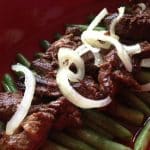Filipino Bistek- Braised Beef Slices with Citrus and Soy Sauce
This beef dish is defined by its strong sweet citrus flavor. Bistek Tagalog (say ‘bees-stek Ta-gah-log’) is a favorite Filipino recipe of braised beef slices cooked in a skillet and flavored with citrus juice from calamansi (the Filipino lime) or lemons and soy sauce. I used tamari, a low sodium, gluten-free soy sauce for this recipe. The layer of large onion ring slices are pan fried before the beef is braised in the same skillet to flavor the entire dish with a robust sensation. This is an easy weeknight meal that I make often when I have little time left to put dinner on the table. This was adapted from a past AsianInAmericamag recipe on this blog. Serves 2 or up to 4 if paired with rice.
Servings: 4 people
Calories: 108kcal
Ingredients
- 1 pound beef sirloin or skirt steak sliced thin (ask your butcher to slice them uniformly if possible)
- 1/2 cup calamansi or lemon juice divided, use 1/4 cup for marinade of beef
- 1/2 cup soy sauce or Tamari low-sodium divided, use 1/4 cup for marinade
- 1/4 pound green beans washed, edges trimmed
- 1 Tablespoon vegetable oil for green beans
- 2 Tablespoons cider vinegar for green beans
- 4 cloves garlic divided, use 2 pieces minced, for green beans, rest for beef
- 2 Tablespoons vegetable oil for beef
- 1 whole white onion sliced
- 1 whole red onion sliced
- 1/2 cup beef broth for sauce
- 1 teaspoon freshly ground black pepper powder
- 1/2 teaspoon sea salt
- boiled rice for serving white or brown
Instructions
- Prepare the beef slices. Using a mallet or the back of a large kitchen knife, pound the meat slices to tenderize it. Do this on each side of the beef till the slice looks even thinner than when you first began. Pre-marinate the beef slices with 1/4 cup calamansi juice (or lemon) and 1/4 cup soy sauce in a medium-sized, non-reactive bowl. Cover and refrigerate for at least 30 minutes or up to 1 hour.
- Prepare the green beans by washing and trimming the edges. Grease a baking tray that will fit all the beans when laid out in a single layer. Drizzle the beans with the extra virgin olive oil, apple cider vinegar, minced garlic and salt. Mix the seasonings well to coat the green beans. Roast the green beans, uncovered in the oven at 375 F for 10 minutes. When done, remove from oven and set aside.
- In a large skillet, over medium high heat, add the vegetable oil. When oil is hot enough, add the sliced white and red onion rings and pan fry for 3 to 5 minutes. Move the onion rings around the skillet to flavor the oil. When onion rings are transparent, remove and set aside.
- Using the same skillet, while maintaining the same medium high heat, add the remaining garlic and pre-marinated beef slices. Braise the beef and cook for about 5 minutes on each side till well done. Remove beef slices from the skillet and set aside.
- Separately, mix remaining 1/4 cup calamansi juice (or lemon),1/4 cup soy sauce, the broth and black pepper powder in a small bowl. Pour this sauce mixture into the same skillet used for cooking the beef. Cook over medium heat and let the liquid reduce. This should take about 3 to 5 minutes. Turn off the heat.
- To assemble on platter: place the roasted green beans on the bottom layer. Arrange the Bistek Tagalog slices on top of the green beans. Pour the citrus-soy sauce over the beef. Garnish with the onion rings. Serve with boiled rice.
- Cook’s comments: I use frozen calamansi concentrate because in the east coast the regular calamansi either cannot be found or if sold in Chinatown are very expensive. Calamansi, the Filipino lime grows seasonally in the west coast or warmer states of the USA. In the Philippines, they grow abundantly in back yards or sold in markets. The Meyer Lemons have the closest flavor to the calamansi. As a substitute, use fresh lemons if more convenient for this recipe.
- Ingredient notes: in the original recipe from past blog posts I used regular soy sauce, Philipine brands purchased at Asian markets. You can use regular soy sauce if that's what you prefer. For this recipe I used tamari sauce low sodium, a non-wheat (gluten-free) soy sauce which is less salty. Tamari sauce is also available at Asian markets, larger supermarkets, specialty stores or online sources here in the USA.
- Hello, Friends! All the images and content on this blog are COPYRIGHT PROTECTED and owned by my media company Besa-Quirino LLC. This means BY LAW you are NOT allowed to scrape, lift, frame, plagiarize or use my photos and recipe content I wrote, on your website, videos, books or media content without my permission. If you want to republish this recipe or content on another website, media outlet or news article, please ASK my permission, re-write it in your own words and simply link back to this blog to give proper attribution. It’s the legal thing to do. Thank you. Email me at [email protected]
Nutrition
Serving: 1g | Calories: 108kcal | Carbohydrates: 3g | Protein: 1g | Fat: 11g | Saturated Fat: 9g | Sodium: 405mg | Potassium: 88mg | Fiber: 1g | Sugar: 1g | Vitamin A: 195IU | Vitamin C: 4.4mg | Calcium: 16mg | Iron: 0.4mg
